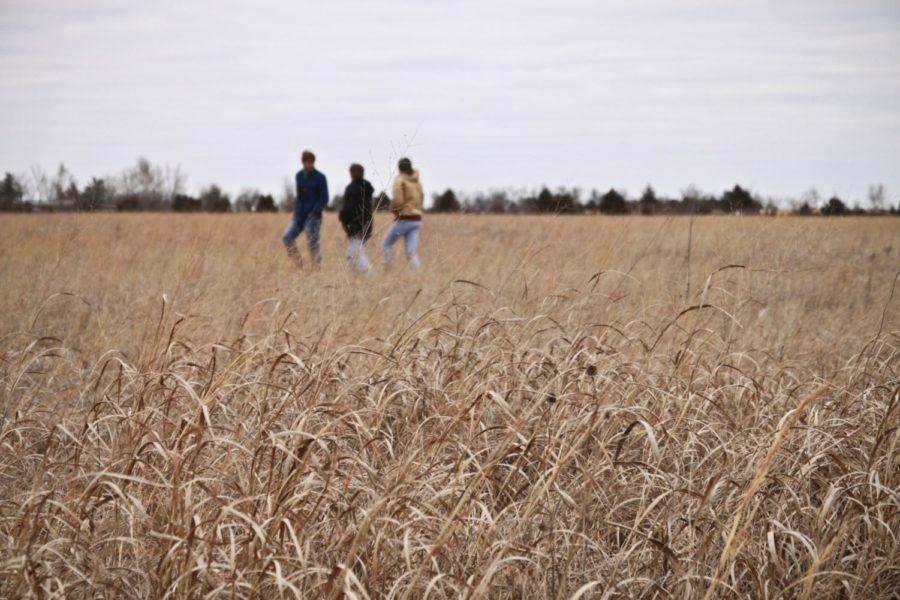Building site choice brings opposition
Students trek through the proposed site for a medical building on the Missouri Southern campus, Northeast of the corner of Duquesne and Newman roads.
As Missouri Southern continues its pursuit of a medical school, some students and conservationists are bringing up opposition to the choice of the construction site.
Currently, the prairie on the Northeast corner of Newman and Duquesne Roads is being surveyed for the site of the new building. For one department, the prairie is more than just a vacant lot.
“Over the years when I’ve taught ecology, I’ve made extensive use of the prairie,” said Dr. John Messick, professor of biology and environmental health. “There are certain kinds of biology that belong outside. I don’t think we ever, as a department, want to do everything in a lab or in the textbook, so I strongly believe we need to do as much biology outside as we possibly can.”
Aside from being an outdoor classroom for the biology department, the prairie is a remnant prairie that holds great value to conservationists.
“Over a third of Missouri was once covered in tall grass prairie and now there is less than one-tenth of one percent left,” said Bob Peterson, junior biology major. “This prairie is listed in the Missouri Conservation department natural resource guide. So we have something here that is valuable and very rare.
“To me, it’s an under utilized, under appreciated resource that has for years been underexposed.”
Steve Clubine, prairie wildlife biologist with the Missouri Department of Conservation, had similar views of the site.
“Each and every one of these prairies is very precious because there are so few left,” Clubine said. “Some of the most endangered plants in North America are on those prairies. Once they’re gone, they’re gone.”
Southern’s biology department and the conservation department both agree the site could be upheld and still be a great source for research.
“A lot of universities would love the opportunity to study these plants, animals and insects on campus,” Clubine said. “What an opportunity Southern has. Students are going to be hard-pressed to see those plants anywhere else.”
But with administration pushing so adamantly for the new building, opposition is pressed for time and hard up for other options.
“I’ve met with Rob Yust twice in an attempt to communicate, but it doesn’t seem that information about the prairie and its importance has been conveyed prior to our meeting,” Peterson said. “I was letting them know that some students are as adamantly opposed as I am. I’m amazed no one else is stepping forward.”
However, administration doesn’t think there is an alternative to the already determined site.
“We don’t have another place for it,” said University President Bruce Speck. “We have land if you look around. But all that land around Turkey Creek is flood plain so you can’t build there.
“We’re not trying to go in and destroy stuff, we are trying to take an opportunity that looks good to us and could benefit the community as a whole.”
Peterson argues that there could be other alternatives, like moving the parking lot on the Southeast corner to the flood plain.
“There’s nothing wrong with having a parking lot on a flood plain. We have one down there now,” Peterson said.
There is also a possibility of limiting the building’s impact on the remnant prairie or using other sites for research.
“In one sense, it would be a loss to the biology department, but in another sense you have to look at the big picture,” Messick said.
Dr. Robert Heth, associate professor of biology and environmental health, said he thinks the property to the north is also remnant prairie and would be a good place to study if it was somehow donated to the school.
Peterson said he has a bigger vision for the prairie, though. He said he would like to see an interpretive trail used on the land that would have signs identifying plants and other species to people who visit.
“It would be an education opportunity that the community could take advantage of,” Peterson said. “If we start conservation research, it could even attract more students to come to Missouri Southern. My opposition isn’t to the building, just save the prairie and use it for what it is.”
Administration said it’s still trying to find a compromise that will work.
“We’re not insensitive to the need to preserve a piece of property that is really very precious,” Speck said. “But how do you do that and move forward in terms of the medical school?”
Your donation will support the student journalists of Missouri Southern State University. Your contribution will allow us to purchase equipment and cover our annual website hosting costs.















